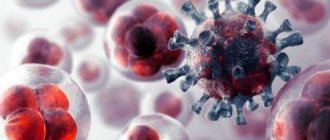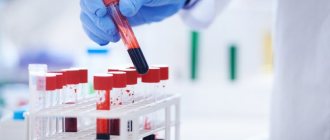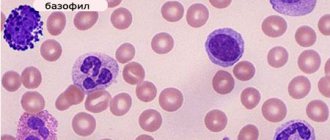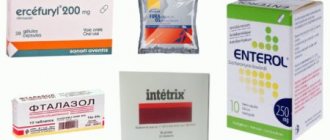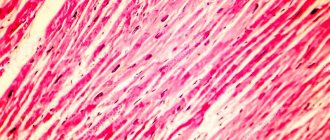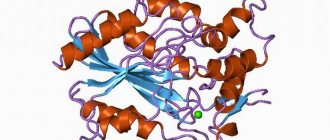What is antithrombin III in a blood test?
Anticoagulant antithrombin III
This indicator refers to the primary plasma anticoagulants and is the main component of the body’s anticoagulant system, that is, it helps maintain blood in a liquid state and prevents the formation of blood clots.
The anticoagulant activity of plasma depends on a number of indicators: antithromboplastins, antithrombins, factors that prevent the self-assembly and maturation of fibrin. The activity of antithrombin III accounts for 75% of the activity of the entire anticoagulant system as a whole. Antithrombin III is the main plasma cofactor of heparin; it is capable of inactivating a number of plasma coagulation factors (thrombin, X, IX, VII, XII factors). Inactivation of thrombin occurs when it irreversibly binds to AT III in the presence of heparin.
Importance of analysis for pregnant women
A coagulogram is one of the important studies, because changes in blood clotting can cause the development of irreversible consequences and complications in a woman’s body. If blood clots form, it can result in a stroke, thrombosis or heart attack. For a pregnant woman's body, such thrombus formation can provoke spontaneous miscarriage or cause premature onset of labor.
Increased blood clotting has a negative impact not only on the expectant mother, but also on the intrauterine development of the fetus. In such a situation, there is an increased likelihood that the development of the baby’s brain will occur with various disturbances, and the child will suffer from a lack of oxygen. That is why it is important to diagnose the dangerous condition of the expectant mother as early as possible, in order to avoid serious problems in the future.
Indications and contraindications for the test
Thrombophlebitis - indication for the test
Indications:
- recurrent thrombotic and thromboembolic pathologies in any forms and manifestations (acute coronary syndrome, acute cerebrovascular accident, pulmonary embolism, disseminated intravascular coagulation syndrome, thrombophlebitis);
- symptoms of worsening blood clotting (increased bleeding of the gums, frequent and profuse nasal, gastric (with ulcers), uterine bleeding, tendency to form subcutaneous hematomas, etc.);
- suspicion of a hereditary deficiency of this factor;
- long-term use of anticoagulants to prevent thromboembolism.
Contraindications. There are no absolute contraindications to this study. A relative contraindication is an inflammatory process in the area of venipuncture.
Preparing and administering the test
Biological material - venous blood
Venous blood is required for the analysis. Blood is taken from a vein under sterile conditions in the treatment room by a nurse. It is advisable to take blood in the morning after an eight-hour overnight fast, but if this condition cannot be met, it is possible to take plasma for analysis at any time of the day, three to four hours after a meal. Before this manipulation, you should also not drink tea, coffee, carbonated drinks, alcohol, or smoke. It is allowed to drink clean water without gas in moderate quantities.
Two to three days before the study, it is necessary to exclude heavy mental and physical stress, since they can also affect the synthetic function of the liver, and, accordingly, the production of AT III.
Indications for clinical laboratory testing of blood composition
The study of blood composition using the coagulogram method is carried out in the following cases:
- Preventive testing of patients over 50 calendar years of age, and who have previously had cases of thrombosis in blood vessels,
- To assess the quantitative composition of antithrombin and the quality of this protein,
- Thromboembolic diseases of the large arteries,
- Myocardial infarction,
- PE (pulmonary embolism),
- Ischemic stroke,
- Pathology thrombophlebitis,
- Complications during pregnancy, miscarriages,
- Fetal freezing in the first trimester of pregnancy,
- Detachment of the walls of the placenta,
- Pathology eclampsia,
- Preeclampsia disease,
- Preeclampsia disease,
- Testing blood composition for proteins type C and type S,
- Testing for lupus type anticoagulant,
- A long surgical operation that lasts more than 240 minutes,
- Severe intoxication of the body,
- Dehydration of the body due to intoxication, through prolonged diarrhea and large amounts of vomit,
- Pathology sepsis,
- State of shock
- Control over the intake of heparins,
- For preventive purposes, arterial thrombosis in women during pregnancy and childbirth,
- Control over the state of the blood structure in patients with bed rest,
- Study after surgery to remove a blood clot.
Clinical blood test during pregnancy
How to properly prepare for analysis?
To study the blood composition for antithrombin using the coagulogram method, only venous blood is taken. Biochemical analysis is not done without preliminary preparation of the body, especially indicators for proteins in the structure of the blood composition.
The material for study must be freshly taken.
In order to obtain the most correct coagulogram value in biochemistry, you need to prepare your body for the test:
- It is recommended to donate blood in the morning on an empty stomach,
- The last meal should be at least 10-12 hours before blood donation,
- For dinner, do not eat fried, salty, fatty foods,
- Do not drink alcohol before submitting material for analysis,
- Stop smoking at least 30-60 minutes before taking biological fluid,
- Two weeks before blood sampling, do not take medications that can affect the structure of the blood,
- If taking medications cannot be postponed, you must inform your doctor.
- Be calm before donating blood and at the time of collection.
Factors influencing the result
Errors in diet are the reason for incorrect results
Three groups of factors can influence the result:
- improper preparation of the patient (non-compliance with diet, severe stress);
- errors in manipulation, blood collection technique, storage conditions and transportation to the laboratory;
- some physiological and pathological conditions that are sometimes ignored when interpreting results (menstruation, pregnancy, prematurity).
Increased level of AT III
Diseases of the pancreas as a cause of increased rates
As a rule, this change indicates reduced blood plasma clotting. In some cases, this is relatively beneficial, for example, in patients who have suffered an acute myocardial infarction, since the risk of repeated thromboembolism in their case can result in severe disability or death. However, a pronounced increase in the level of AT III can also be a dangerous condition; it poses a high risk of hemorrhagic complications, for example, in patients with chronic gastric and duodenal ulcers, varicose veins of the esophagus, hemorrhoids, etc.
An increase in the value of antithrombin III is possible in several cases.
- Pathology of the hepatobiliary system.
- Acute hepatitis of viral or alcoholic etiology leads to temporary changes in the synthetic function of the liver. There may be an increase in the formation of AT III and a decrease in the production of coagulation factors, but, as a rule, these fluctuations stop during the period of remission.
- Pathology of the gallbladder and bile ducts can also lead to stagnation of bile (cholestasis) and liver damage, so it is worth promptly identifying such pathologies as: chronic calculous cholecystitis, opisthorchiasis, chronic cholangitis, tumors of the gallbladder and head of the pancreas.
- Treatment with anticoagulants. Indirect anticoagulants (warfarin, neodicoumarin) inhibit the formation of vitamin K-dependent coagulation factors (II, VII, IX, X) in the liver, thus they reduce the coagulation of blood plasma without the help of antithrombin III, which increases its concentration in the plasma.
- Vitamin K deficiency. Vitamin K stimulates the formation of coagulation factors, including prothrombin (the precursor of thrombin), accordingly, the lack of prothrombin does not provide AT III with a sufficient amount of substrate for neutralization, and the level of AT III in plasma increases.
- Severe inflammatory processes of any localization.
Taking anticoagulants increases antithrombin III levels
Decoding the analysis results
You can get an accurate and reasonable interpretation of the results of the analysis from your attending physician.
The main indicators of a coagulogram are:
- Fibrinogen is a protein that is involved in the formation of the liver and is one of the main components of blood. In addition, it has a direct effect on the process of thrombus formation.
- Prothrombin time is the time during which fibrin is formed from fibrinogen under the influence of thrombin. The pregnancy period is characterized by an increase in thrombin time, which is associated with an increase in the amount of fibrinogen in the blood.
- The thrombosed index is a value that is determined by the percentage ratio of the clotting period of the plasma of a pregnant woman with control plasma.
- APTT is the time during which blood clotting occurs.
- Lupus anticoagulant is a specific body that should normally be absent from the body of the expectant mother.
- Platelets are red blood cells that are produced in the bone marrow. During pregnancy, their slight decrease is allowed, but if there is a strong deviation from the norm, this may indicate a serious illness.
- Dimers are an indicator responsible for thrombus formation and help to detect thrombosis in a timely manner.
- Antithrombin 3 is a protein, the presence of which in a woman’s body during pregnancy can slow down the blood clotting process.
Reduced AT III level
The cause of low antithrombin III levels is DIC syndrome
A decrease in this indicator indicates a tendency to thrombus formation and its complications (ischemic organ pathology).
The reasons for the decrease in level are as follows:
- congenital deficiency of this protein in the form of quantitative or qualitative deficiency;
- thromboembolism and disseminated intravascular coagulation syndrome (increased antithrombin costs as a result of the body’s fight against pathological blood clotting);
- severe chronic liver pathology with the development of liver failure (cirrhosis, liver cancer);
- the use of direct anticoagulants (unfractionated heparin and its low-molecular-weight analogs), since heparin greatly enhances the irreversible binding of AT III to thrombin, and the costs of this anticoagulant are correspondingly increased;
- long-term use of oral contraceptives;
- menstruation;
- third trimester of pregnancy;
- prematurity.
Antithrombin 3 study
A protein with a special specificity, which is simply necessary for blood clotting, is antithrombin 3. Its main function in a woman’s body during pregnancy is to prevent the formation of blood clots. If antithrombin 3 in the blood is low, this indicates a risk of blood clots, and if the level is increased, the risk of bleeding increases.
Patients whose antithrombin 3 is greatly reduced fall into a separate group with an increased risk of developing thrombosis. A hereditary predisposition to a deficiency of this protein is extremely rare, and in this case, blood clots begin to bother a woman at the age of 20-30.
Antithrombin 3 in small quantities in a woman’s body during pregnancy can exist in two forms:
- Normal antithrombin is produced in the body, but its quantity is not enough;
- A sufficient amount of protein is produced, but it is dysfunctional.
Correction of antithrombin III levels
Therapeutic tactics depend on the cause of the change in the level of the indicator
Firstly, it is worth identifying the possible cause of this change and trying to stop it. For example, adjust the doses of anticoagulants taken, eliminate vitamin K deficiency (diet, Vicasol), cancel oral contraceptives, carry out pathogenetic and, if possible, etiological treatment in case of diseases of the liver and biliary system.
Secondly, if there is a lack of antithrombin III, it can be replenished by intravenous administration of the appropriate drug. Indications for such treatment: hereditary deficiency of AT III, disseminated intravascular coagulation syndrome (defibration syndrome), arterial thrombosis and embolism, phlebitis and thrombophlebitis. However, during pregnancy, such a drug is prescribed only for health reasons, preferably the administration of heparin.
If it is necessary to use AT III and heparin simultaneously, the dose of the latter should be gradually reduced to prevent hemorrhagic complications.
Treatment of abnormalities
Drug therapy is prescribed by a doctor if the indicators strongly deviate from the norm. For pregnant women, the first trimester is carried out only from the second month, in a situation where deviations directly threaten pregnancy. Low indicators for pregnant women in the third trimester are not corrected at all. In other cases, therapy is selected depending on the cause of the deviation, its degree, and has two vectors:
- Treatment of the underlying process, the disease that caused the deviation, if possible.
- Normalization of antithrombin levels 3.
Treatment of the underlying pathology is carried out by a specialist. Blood clotting is normalized by prescribing anticoagulants/mild coagulants or low molecular weight heparins. Sometimes expectant mothers are given donor blood plasma.
